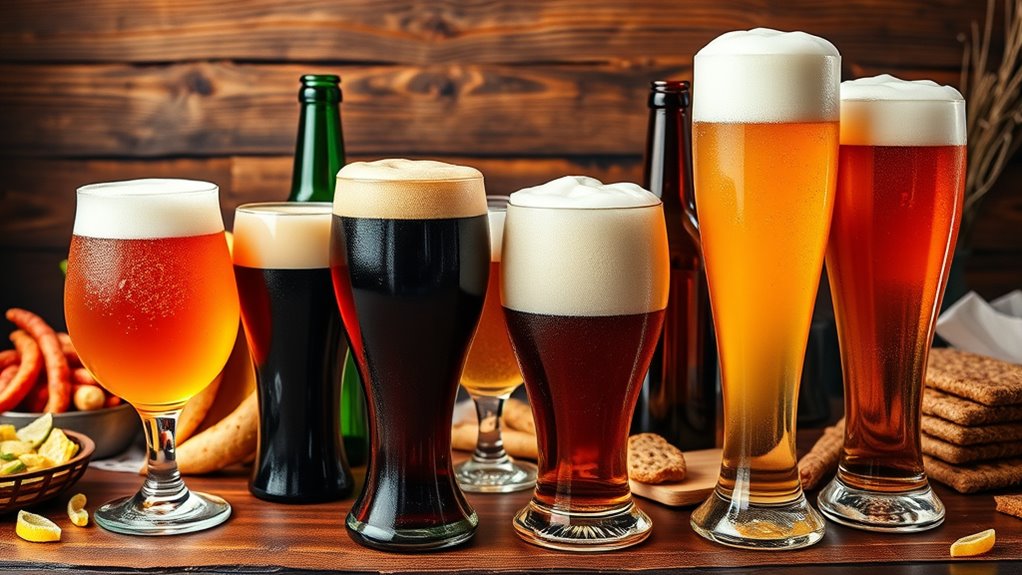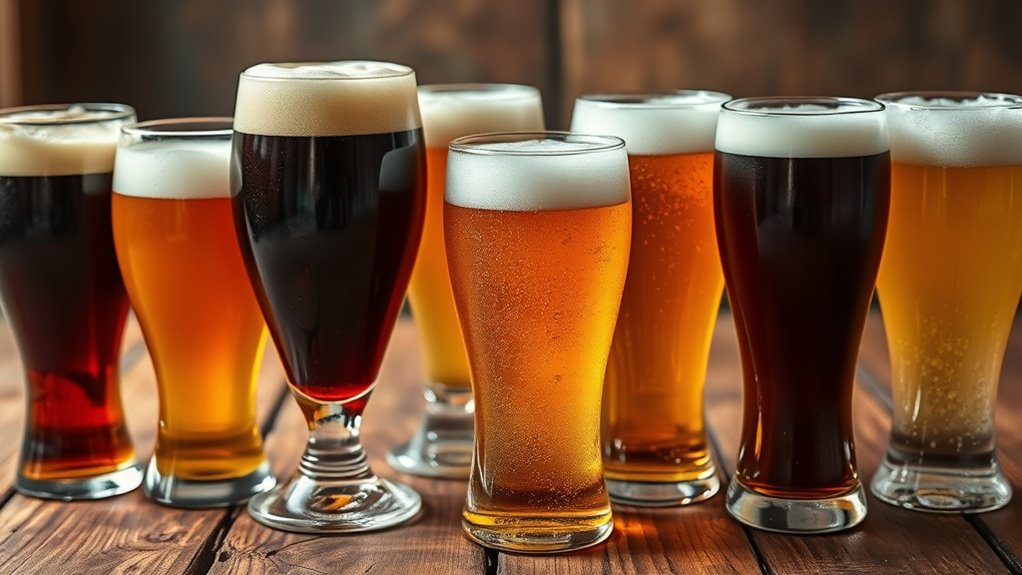Explore how beer reflects the diverse cultures and histories around the world. From Germany’s pure lagers and wheat beers to Belgium’s fruity, spicy ales, each style tells a story rooted in tradition. American craft beers push bold flavors, while Japanese lagers emphasize craftsmanship. Local ingredients and customs shape unique regional brews. If you keep exploring, you’ll uncover even more fascinating backgrounds and innovations behind each distinct style.
Key Takeaways
- Diverse beer styles reflect regional ingredients, climate, and cultural traditions, from German lagers to Belgian ales and American craft beers.
- Historical laws like Germany’s Reinheitsgebot and local customs shape unique brewing practices worldwide.
- Innovation, including modern technology and experimental techniques, drives the evolution of global beer styles.
- Beer serves as a cultural artifact, embodying local history, identity, and social customs across different regions.
- Tasting international beers reveals rich stories and traditions, highlighting the connection between brewing and cultural heritage.

Have you ever wondered how beer varies from one country to another? It’s fascinating to see how different cultures have shaped their own unique brewing traditions, flavors, and stories. When you explore beer around the world, you quickly realize that it’s more than just a drink—it’s a reflection of history, climate, ingredients, and local customs.
Exploring global beers reveals rich stories of culture, history, and local ingredients.
For instance, in Germany, you’ll find a deep-rooted love for lagers and wheat beers, with the Reinheitsgebot law influencing the purity and ingredients used in brewing. German beers often emphasize malty sweetness or crisp, clean finishes, and their brewing heritage is celebrated through Oktoberfest and countless regional styles.
Meanwhile, in Belgium, the story takes a different turn. You encounter a wide array of complex, often fruity or spicy ales like Trappists, saisons, and lambics. These beers are crafted with a focus on fermentation techniques and wild yeasts, showcasing a tradition that’s centuries old. Belgian brewers often balance tradition with innovation, creating beers that are both historical artifacts and modern delights.
Across the Atlantic, the United States has become a playground for craft beer enthusiasts, pushing boundaries with innovative styles and bold flavors. From hop-forward IPAs to sour ales and barrel-aged stouts, American brewers are constantly experimenting, driven by a desire to stand out and express local ingredients and creativity.
Their stories are often rooted in the desire for independence and a break from European traditions, resulting in a diverse beer landscape that keeps evolving. In Asia, countries like Japan and China are developing their own beer stories, blending traditional ingredients with modern brewing techniques.
Japanese lagers, for example, are renowned for their crispness and precision, reflecting a culture that values harmony and craftsmanship. Meanwhile, in Africa and Latin America, local ingredients and climate influence beer styles, creating regional flavors that tell stories of indigenous crops and cultural adaptations.
Additionally, modern AI technologies are increasingly influencing brewing processes, allowing brewers to analyze data and develop new styles tailored to consumer preferences enhancing innovation.
In every corner of the world, beer’s story is intertwined with local customs and history. Whether it’s the small, family-owned breweries in Eastern Europe or the massive, innovative breweries in North America, each style has a tale to tell.
As you taste different beers from around the world, you’re not just enjoying flavors—you’re experiencing centuries of tradition, cultural identity, and the passion of brewers who’ve dedicated their lives to perfecting their craft. Beer isn’t just a beverage; it’s a global narrative, woven through centuries and continents, waiting for you to explore its stories.
Frequently Asked Questions
How Do Brewing Techniques Vary Across Different Countries?
You’re curious about how brewing techniques differ across countries. In each place, brewers adapt methods based on local ingredients, climate, and traditions.
For example, Germany’s lagering process creates clean, crisp beers, while Belgium’s spontaneous fermentation results in complex flavors. You’ll notice variations in fermentation times, types of malt, and yeast strains, all shaping each region’s unique beer styles.
These techniques reflect cultural heritage and influence the diverse flavors you enjoy worldwide.
What Are the Rarest Beer Styles Globally?
You’re fishing in uncharted waters when exploring rare beer styles globally. These include Gueuze from Belgium, a wild, tart blend, and Gose, a salty German brew.
Other hidden gems are American Barleywine and South African Umqombothi. These styles are hard to find but worth seeking out, offering a taste of brewing history and local culture.
Their rarity makes them treasures for beer enthusiasts craving unique, authentic experiences.
How Does Beer Aging Affect Flavor Profiles?
You might wonder how aging impacts beer flavors. When you age beer, the flavors often develop more complexity, with malts mellowing and hop bitterness fading.
Some beers, especially strong or sour varieties, gain depth and richness over time. However, not all beers benefit from aging—light, hoppy beers may lose their freshness.
Proper storage is key, as temperature fluctuations can cause undesirable changes.
What Role Do Local Ingredients Play in Regional Beers?
Imagine you’re tasting a Belgian Trappist ale brewed with locally sourced herbs and spices. Local ingredients shape regional beers by reflecting the area’s climate, culture, and available resources.
For example, using indigenous hops or grains can create unique flavors that define a region’s beer identity. You’ll notice that these ingredients not only influence taste but also connect you to the local terroir, making each brew a distinct reflection of its home.
How Has Beer Culture Evolved Over Centuries Worldwide?
You see, beer culture has evolved through centuries by blending tradition with innovation. You’ve witnessed how local ingredients shape regional flavors, and how brewing techniques adapt over time.
Cultural exchanges, globalization, and craft movements influence your beer choices today. You’re part of a dynamic history where ancient practices meet modern creativity, making beer a reflection of diverse societies.
Embracing this evolution, you experience a rich, ever-changing beer landscape worldwide.
Conclusion
As you explore the diverse styles and stories behind beer worldwide, you realize it’s more than just a drink—it’s a cultural tapestry. Each sip offers a glimpse into traditions, history, and innovation that shape communities. Keep an open mind and taste broadly; there’s always more than meets the eye. After all, understanding beer around the world is a journey, and sometimes, the more you learn, the more you realize how much there is to uncover—it’s a never-ending adventure.









